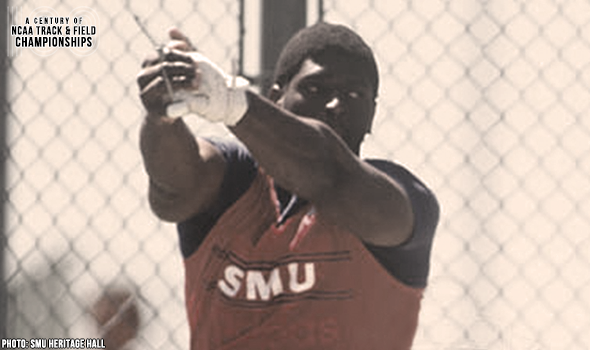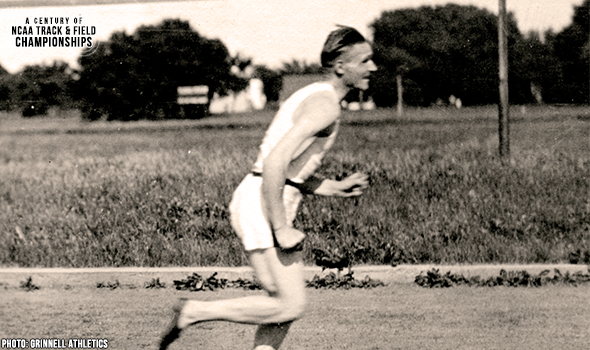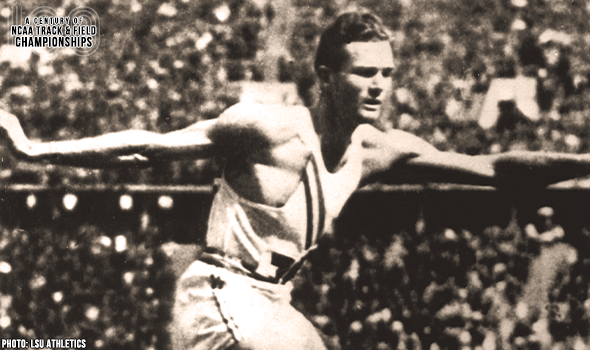
Weir Wouldn’t Be Denied In Throwing Events
It took a sometimes-frustrating three years, but Robert Weir finally beat fellow SMU teammate Richard Olsen in the hammer throw.
Weir thought he had it in the second year of their rivalry at the 1982 NCAA Division I Outdoor Track & Field Championships in Provo, Utah.
That’s when Weir led the competition until the last round at 73.24m (240-3). But Olsen, the defending champion, came back from a 7-foot deficit with a final effort of 73.30m (240-6) to snatch the victory. Weir’s only consolation from a second-straight NCAA runner-up finish to his teammate was leaving with the meet record, having tossed 73.34m (240-7) in the qualifying round.
“I knew from past experience that Richard will always be there. And he was,” Weir said.
That was the last time Weir lost to Olsen, who then owned a career 10-0 head-to-head edge in the hammer.
The pendulum swung in Weir’s favor in 1983, and the Englishman threw first notice with a world best in the weight throw of 23.64m (77-6¾) in early January before winning a second NCAA Indoor title in March. In April, he notched his first hammer win over Olsen and took Olsen’s collegiate record away at 74.06m (243-0).
At the 1983 NCAA DI Outdoor Championships in Houston, no one could touch Weir. After a first-round foul he took the lead at 72.60m (238-2) – a mark that would end up being long enough to win but would be his shortest effort of the day.
In Round 4, Weir broke his own meet record with a 73.86m (242-4) heave, then followed up by improving his CR to 74.42m (244-2) to win by more than 11 feet. Olsen ended up third behind Declan Hegarty of Boston University.
Interestingly, Weir’s CR wasn’t a PR. The previous fall he had won the Commonwealth Games with an “all-dates” collegiate best of 75.08m (246-4).
Weir’s postseason success also repeated in 1983 as he extended his world best in the weight throw to 24.14m (79-2½) in September, even though his specific training for the event had ended in March.
The NCAA and collegiate track & field will mark a momentous milestone in the spring of 2021 -- the 100th anniversary of the NCAA Championships and with that, the NCAA Track & Field Championships. In June 1921, the University of Chicago hosted the first track & field championships in NCAA history.
This point can’t be emphasized enough: Not only was the event the first for NCAA track & field, but the first championships for any sport under the sponsorship of the NCAA.
To celebrate, over each of the next 365 days, the U.S. Track & Field and Cross Country Coaches Association (USTFCCCA) will celebrate moments, student-athletes, and coaches that have made a century’s worth of championships special. From humble beginnings to important historical milestones to the modern-day, collegiate track & field has evolved with the American society.
The 2021 edition of the NCAA Division I Outdoor Track & Field Championships begin with preliminary round action on May 27-29 in Jacksonville, Fla., and College Station, Texas. The championships final site and culmination of the celebration is slated for June 9-12, 2021 at the newly rebuilt Hayward Field in Eugene, Ore.

SIU’s Roggy Dominated The Javelin In 1978
Bob Roggy won the javelin title at the 1978 NCAA DI Outdoor T&F Championships by more than 20 feet. Roggy qualified first for the final with a MR heave of 89.30m (293‑0).

Makusha Made History In Bowerman Year Of 2011
Ngoni Makusha became just the fourth man in meet history to win individual titles in both the 100 and LJ. It was his 3rd career LJ crown and he set a CR in the 100 of 9.89.

George Mason’s Gage Shocked The NCAA LJ In 1988
Nena Gage won the long jump at the 1988 NCAA DI Outdoor T&F Championships in a shocking upset over Gail Devers.

Texas’ Thompson Marveled In NCAA Distance Events
Jerry Thompson won three career distance titles at the NCAA Outdoor T&F Championships. His first came in 1943. Then he won again in 1947 & 1948 after serving in World War II.

Grinnell’s Paulu Sprinted To NCAA History
Leonard Paulu was the first athlete to complete the 100-200 double in NCAA Outdoor Track & Field Championships history in 1922. That also made him the 1st to win back-to-back 100 titles, too.

Scott Won Back-To-Back NCAA Hammer Titles
Candice Scott won back-to-back hammer throw titles at the NCAA DI Outdoor T&F Championships in 2003 & 2004. Scott set a meet record of 69.77m (228-11) in that first year.

Drouin Soared To The Bowerman In 2013
Derek Drouin won two career HJ titles at the NCAA DI Outdoor T&F Championships. When Drouin won in 2013, he was only the fourth man to clear 2.34m (7-8) in meet history.

Watts Made Quick Work Of NCAA 400
Quincy Watts set a meet record in the 400 of 44.00 at the 1992 NCAA DI Outdoor Track & Field Championships. It lasted 25 years until 2017.

Iowa State’s Koll Rolled To 5K-10K Crowns
Lisa Koll won three career titles at the NCAA DI Outdoor T&F Championships in dominant fashion. Her average margin of victory in those 5K & 10K races was 37.73 seconds.

LSU’s Hardin Completed Unique 440-220H Double Twice
The nearly unheard of 440-220H double was so nice that Glenn Hardin did it twice! Hardin became the first to do so in meet history in 1933 and then swept them again in 1934.

